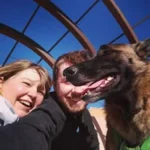Psst! Hey, this is a super old article. Click here to read the new and improved version.
Getting a puppy can be an overwhelming experience. No matter how much or how little planning you did beforehand, when the pup arrives home, it’s common for new owners to freeze up and go, “what do I do now?”
The following is a list of four critical steps. Work on each one, and you’ll lay the foundation for a great life-long relationship with your new friend.
1. Crate Train
A crate is the most valuable piece of dog equipment you will ever buy. Really. So if you haven’t purchased one yet, your first step should be to get one.
A crate (kennel) makes house breaking much easier. It’s a safe place to keep your puppy when you can’t supervise. Many people resist the idea of crate training because they think it’s like putting the dog in jail. “I wouldn’t want to live in a cage” is a common refrain. Your puppy will not share this reluctance with you, though. Dogs are den animals and while you see a cage, your pup (and later your adult dog) sees a safe, comfortable retreat from the stress of the outside world.
See also: Dog Crates: the Good, the Bad and the Ugly
2. Socialize, Socialize, Socialize
If your pup is under the age of four months, congratulations! You have a great opportunity here. The age of four to sixteen weeks is generally known as a puppy’s “critical socialization window.”
What she learns about the world now will have a strong effect on her personality the rest of her life. Introduce her to as many new people, places and things as possible. Make it a positive experience. Give her treats and praise her in potentially scary situations – at ball games, in pet stores, when strangers bend over her to tell her what a cute puppy she is, etc.
Socialization Don’ts:
-Don’t let any new experience overwhelm the pup. For example, If she is wary of children, don’t just plop her down with a group of kids and expect her to be okay.
-Don’t use the dog park for socialization. In addition to putting your under-vaccinated puppy at risk for whatever canine diseases are going around the neighorhood, the majority of dogs at dog parks are poorly behaved. Your pup could learn all the wrong things. Not to mention that if she meets an aggressive dog that hurts her, it could “scar her for life.”
3. Schedule a Vet Visit
Establish a relationship with your vet right off the bat by scheduling a check up within a couple weeks of bringing your new charge home. If the puppy hasn’t been spayed/neutered yet, you can discuss setting up an appointment. If you got him from a shelter or rescue group he’s probably had his first shots, but your vet can tell you which ones he’ll need next. Most importantly, this is another opportunity for socialization. Taking your pup to the vet early on will get him used to the whole experience. Try to make it positive and not scary, and your pup will start to get into a good vet visit habit and be easier to handle at the vet’s office when he’s older and larger.
Hi again! This is a super old article. Click here to read the new and improved version.
4. Start Training
The earlier you begin basic training, the better. See, your adorable little fluff ball is cute and innocent – now. He happily follows you everywhere, and enjoys doing what you ask of him. But eventually, this wonderful time will come to an end. When he’s about six months old, he’ll enter his adolescent phase. And, as anyone who has ever been a parent to a teen or preteen knows, he’ll start to think he knows better than you. When you ask him to do something, instead of “okay!” his new response will be, “um, no.” So get a head start on basic obedience training now, before he becomes a teenager.
Also, now is your chance to nip any behavior problems in the bud before they become unmanageable – better to teach your lab puppy not to pull on leash now than to try to fix a pulling problem when he’s nine months old and weighs sixty pounds.
Not sure how to train your puppy? Check out the video post on dog training basics, How to Teach Your Dog Practically Anything.
See also:
Puppy Training Games
Housetraining 101: the Basics
Housetraining 101: 9 Steps to a Potty-Trained Pup
Here’s a tip that I didn’t use with my own puppies, but now that I know better, I really wish I had. Consider enrolling in a puppy kindergarten (or puppy preschool) class. These classes are not just obedience classes for younger dogs, but they put the focus on basic manners, and introducing puppies to other puppies, people, and things. You get socialization and training, all rolled into one. Since every pup in class is required to be up to date on their shots, you don’t have to worry about your pup getting sick.
Check out these other posts:
A Beginner’s Guide to Adopted Dog Ownership
43 Tips for New Puppy Owners
Is My Puppy CRAZY? A Short Guide to Puppy Behavior


